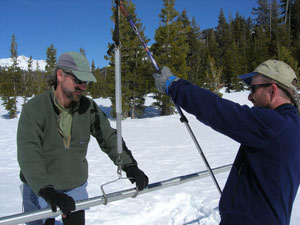One of the easiest ways of measuring snowfall is to remove the funnels and cylinders from a rain gauge, then carefully measure a volume of anti-freeze to put in the canister. Snow falls directly into the canister and melts in the anti-freeze, and the whole apparatus is weighed and put back in place without emptying. If the gauge isn’t emptied before putting back in the field, then the total weight must be recorded so it can be deducted when it comes to measuring snowfall again.
Another simpler method uses again a 100 mm (4 in) or 200 mm (8 in) rain gauge with the funnel etc removed. Once the snowfall is finished accumulating in the gauge, the snow can be melted by adding some lukewarm water. The warm water used to melt the snow is subtracted from the overall total weight once all the snow is melted and weighed.
By weighing the liquid (and removing the weight of the anti freeze or lukewarm water added) the depth of water can be measured that originally fell as snow. We can convert the weight of water to volume as the density of water at around room temperature is almost exactly 1.000 g/mL or 1 kg/L (one cubic inch equals 0.036127Lb).
Another instrument used when measuring snowfall is the ‘snow pillow’. This is a device for measuring snow pack, especially for automated reporting stations such as SNOTEL.  The snow pillow measures the water equivalent of the snow pack based on hydrostatic pressure created by overlying snow. Any discrepancy due to bridging in the snow is minimized by the large size of the pillow, generally about 3 metres (120 in) square. Snow pillows can also be used to estimate the snow weight on a roof to warn of potential for roof collapse.
The snow pillow measures the water equivalent of the snow pack based on hydrostatic pressure created by overlying snow. Any discrepancy due to bridging in the snow is minimized by the large size of the pillow, generally about 3 metres (120 in) square. Snow pillows can also be used to estimate the snow weight on a roof to warn of potential for roof collapse.
The Rangers pictured above are using a device called the Mount Rose Snow Tube. This measures snow depth and water content to determine snow density. A sensitive spring balance is graduated in both equivalent inches and centimeters of water. These are often used in snow surveys conducted four to five times per year and, can be used to compare seasonal differences across many years. For example snow surveys in the United States Yosemite Park show a record snow depth of 232.9 inches on 1 April 1969.
